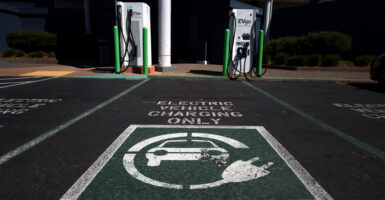California’s electric vehicle agenda will require costly upgrades to the state’s electric grid infrastructure if it is to be realized, according to a new study published in the scientific journal Proceedings of the National Academy of Sciences.
The state, often heralded as a national leader when it comes to EVs, is set to ban the sale of purely gas-powered passenger vehicles in the state after 2035 and heavy-duty trucks that burn fossil fuels starting in 2036. The infrastructure upgrades reportedly needed to support the projected rise of EVs in the state could cost anywhere between $6 billion and $20 billion, according to the study.

The study identifies “feeders,” or transmission lines that carry electricity from the site of generation to its end user, as a key type of infrastructure that needs extensive upgrades by 2045 in order to meet targets set by California’s aggressive EV policies. There is a “substantial need” for 50% of all feeders in the state to receive upgrades by 2035, and for 67% of feeders by 2045, according to the study.
The state will also need to increase the amount of energy that it is able to distribute by about 25 gigawatts by 2045 to meet demand for public and private EV charging stations—upgrades that will cost anywhere between $6 billion and $20 billion, the study states. But it takes nearly 2.5 million solar panels or 310 utility-scale wind turbines to produce just 1 GW of power, according to the Department of Energy.
“The imminent challenges confronting California serve as a microcosm of the forthcoming obstacles anticipated worldwide due to the prevailing global trend of EV adoption,” the study states.
California is also expecting to continue its advance toward its goal of having 100% zero-emissions power generation by 2045. The state figures to rely heavily on wind and solar power to meet that target, given that the state’s sole major nuclear power plant may have to close for good after its five-year life span extension granted by state regulators expires.
While the state is changing how it sources electricity over time and adding demand with policies like those pushing EVs, the study’s authors project that electricity demand growth will actually drive down electricity costs in the state over time. California had the second-highest cost of electricity per unit of any state in the continental U.S. in January, trailing only Rhode Island, according to data from the U.S. Energy Information Administration.
The office of Democratic California Gov. Gavin Newsom and the California Energy Commission did not respond immediately to requests for comment.
Originally published by the Daily Caller News Foundation





























